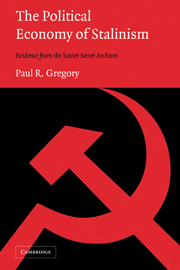Book contents
- Frontmatter
- Contents
- Illustrations
- Tables
- Preface
- 1 The Jockey or the Horse?
- 2 Collectivization, Accumulation, and Power
- 3 The Principles of Governance
- 4 Investment, Wages, and Fairness
- 5 Visions and Control Figures
- 6 Planners Versus Producers
- 7 Creating Soviet Industry
- 8 Operational Planning
- 9 Ruble Control: Money, Prices, and Budgets
- 10 The Destruction of the Soviet Administrative-Command Economy
- 11 Conclusions
- Appendix A Archival Sources
- Appendix B The Structure of the State
- Bibliography
- Index
5 - Visions and Control Figures
Published online by Cambridge University Press: 03 December 2009
- Frontmatter
- Contents
- Illustrations
- Tables
- Preface
- 1 The Jockey or the Horse?
- 2 Collectivization, Accumulation, and Power
- 3 The Principles of Governance
- 4 Investment, Wages, and Fairness
- 5 Visions and Control Figures
- 6 Planners Versus Producers
- 7 Creating Soviet Industry
- 8 Operational Planning
- 9 Ruble Control: Money, Prices, and Budgets
- 10 The Destruction of the Soviet Administrative-Command Economy
- 11 Conclusions
- Appendix A Archival Sources
- Appendix B The Structure of the State
- Bibliography
- Index
Summary
“We are becoming a country of metal, a country of the automobile, a country of the tractor.”
[Stalin, November 7, 1929]“Not everyone has the nerves, strength, character, and understanding to appreciate the tremendous breakup of the old and the feverish construction of the new … we are bound to have those who are exhausted, distraught, worn-out, despondent, and lagging behind — and those who go over to the enemy camp. These are the inevitable costs of revolution.”
[Stalin in a private letter to Maxim Gorky, January 17, 1929.]The previous chapter explained how the Soviet leadership chose optimal investment by weighing investment against the loss of worker effort. This chapter is about the output plans — five-year plans and annual plans — that gave the Soviet economy its name as a “planned economy.” The investment and output plans were linked at least in theory: Output plans specified the increases in production, but, in order to produce more, producers needed more capital. The investment plan was supposed to provide enough new capacity so that the planned output increases could be achieved.
The linkage between investment and planned output increases existed in practice. When managers were able to convince their superiors that their output targets could not be achieved, they were often offered more investment. On November 3, 1935, a meeting of the “Commission on Procurement of Timber in Gorky Region” was called to discuss the Gorky region's request to cut its timber production target by 8 percent.
- Type
- Chapter
- Information
- The Political Economy of StalinismEvidence from the Soviet Secret Archives, pp. 110 - 125Publisher: Cambridge University PressPrint publication year: 2003



